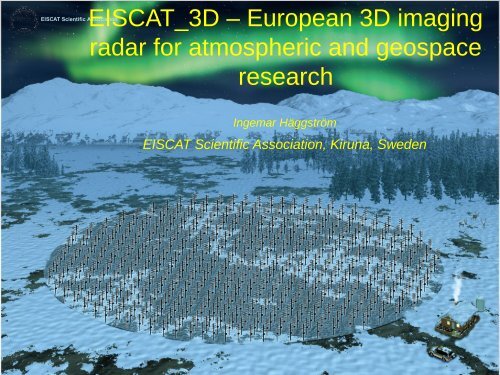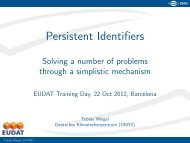EISCAT_3D â European 3D imaging radar for atmospheric ... - EUDAT
EISCAT_3D â European 3D imaging radar for atmospheric ... - EUDAT
EISCAT_3D â European 3D imaging radar for atmospheric ... - EUDAT
Create successful ePaper yourself
Turn your PDF publications into a flip-book with our unique Google optimized e-Paper software.
<strong>EISCAT</strong>_<strong>3D</strong> – <strong>European</strong> <strong>3D</strong> <strong>imaging</strong><br />
<strong>EISCAT</strong> Scientific Association<br />
<strong>radar</strong> <strong>for</strong> <strong>atmospheric</strong> and geospace<br />
research<br />
Ingemar Häggström<br />
<strong>EISCAT</strong> Scientific Association, Kiruna, Sweden<br />
1
<strong>EISCAT</strong> multi-site research infrastructure<br />
studies how Earth’s atmosphere is coupled to space<br />
is uniquely located <strong>for</strong> studies into arctic ionosphere<br />
current members<br />
China<br />
Finland<br />
Japan<br />
Norway<br />
Sweden<br />
United Kingdom
<strong>EISCAT</strong> Scientific Association<br />
Contributing:<br />
<strong>EISCAT</strong> Incoherent Scatter Radars<br />
Svalbard<br />
Sodankyla<br />
UHF<br />
Kiruna<br />
UHF<br />
Tromso<br />
VHF<br />
Tromso<br />
UHF<br />
2 dynasondes<br />
TRO<br />
ESR<br />
- 3 Incoherent Scatter Radars<br />
- HF Heating Facility<br />
- 2 Dynasondes<br />
Tromso HF Heating<br />
Annual operation 3.2 M€
<strong>EISCAT</strong>_<strong>3D</strong><br />
is Research Infrastructure<br />
<strong>for</strong> the Environment on<br />
ESFRI Roadmap<br />
offers the link to other environmental research<br />
helps extending user community<br />
helps attracting new member countries<br />
enhances chances <strong>for</strong> international<br />
collaboration <strong>for</strong> the association and <strong>for</strong><br />
individual users<br />
Ingemar Häggström March 2013
How will it look<br />
Baseline: core site & 4 remote sites<br />
community agrees on list of 7 potential sites<br />
will permit observations combined with rocket<br />
flights from Andoya in Norway and Esrange in<br />
Sweden<br />
a possible concept
Implementation Cost Estimate<br />
Measurement Capability Comparison<br />
Measurement Type<br />
Current<br />
UHF<br />
t/s<br />
Future<br />
E<strong>3D</strong><br />
t/s<br />
Improvement<br />
Factor*<br />
better than:<br />
Isotropic parameters: 110 km altitude 1.0 0.1 10<br />
Isotropic parameters: 300 km altitude 5.0 0.2 25<br />
Vector velocities: 110 km altitude 500.0 10.0 50<br />
Vector velocities: 300 km altitude 2000.0 25.0 80<br />
Monitoring standard data products at 70 - 1200 km: n e ,T e T i ,v i<br />
E<strong>3D</strong> New Measurement Capabilities<br />
instantaneous, adaptive control of beam positions<br />
simultaneous multiple beams/interlaced beams<br />
high-resolution coding of polarisation, phase and amplitude<br />
aperture synthesis <strong>imaging</strong> – small-scale <strong>3D</strong> <strong>imaging</strong>(sub-beam-width)<br />
multi-beam volume <strong>imaging</strong> – large-scale <strong>3D</strong> <strong>imaging</strong><br />
full-profile vector measurements – large/small-scale <strong>3D</strong> vector <strong>imaging</strong><br />
high-speed object tracking<br />
* estimated <strong>for</strong> 3 MW Tx: improvement at least x 10 better<br />
3) integration time, t <strong>for</strong> 1% accuracy ne, Te Ti; 1% accuracy v at plasma density of 2 x 1011 m-3, within<br />
100,000 km2 of core site, assuming five remote stations, same transmitter power as the current <strong>EISCAT</strong>
Anticipated Funding Applications<br />
in competition with Research Infrastructures from other fields<br />
Baseline design 135 MEU*<br />
Norway: proposal October 2012<br />
Sweden: proposal March 2013<br />
Finland: roadmap proposal February 2013<br />
Japan: roadmap proposal March 2013<br />
UK included <strong>EISCAT</strong>_<strong>3D</strong> on roadmap<br />
UK, China & Other Countries<br />
<strong>EISCAT</strong>_<strong>3D</strong><br />
Norway<br />
other milestones<br />
finalize new <strong>EISCAT</strong> agreement November 2013<br />
<strong>EISCAT</strong>_<strong>3D</strong> preliminary design review October 2014<br />
(*10% contingency)<br />
Japan<br />
Sweden<br />
Finland<br />
Ingemar Häggström March 2013
Implementation Time Line 2014 - 2021
<strong>EISCAT</strong>_<strong>3D</strong> (in 2D)<br />
● Transmission<br />
– 10MW<br />
– High modulation<br />
– Radial resolution<br />
● Reception<br />
– Multiple narrow beams<br />
– Angular resolution<br />
● Tx+Rx<br />
– Volumetric data<br />
● Multisite<br />
– Distrbuted receivers<br />
– Wind fields<br />
9
Design Study: system diagram<br />
10<br />
I. Häggström: <strong>EISCAT</strong>_<strong>3D</strong>,2013
<strong>EISCAT</strong> Scientific Association<br />
Similarity to modern radio astronomy<br />
•SKA project<br />
•artist image below<br />
•LOFAR (Low Frequency Array)<br />
•in fact one LOFAR international site have been installed as a test and technology prototyping<br />
receiver site <strong>for</strong> <strong>EISCAT</strong>_<strong>3D</strong> in Northern Finland in 2012.<br />
•But <strong>EISCAT</strong>_<strong>3D</strong> has an additional dimension!<br />
11
Level 2 beam<strong>for</strong>ming is done in a<br />
computer network<br />
12<br />
I. Häggström: <strong>EISCAT</strong>_<strong>3D</strong>, 2013
Data flow<br />
● Each antenna<br />
– 30 Msamples/s (30MB/s)<br />
● Antenna group (core site)<br />
– Computes a number of (broad) beams from a small<br />
number of antennas (FPGAs)<br />
– 100 antennas → 1 beam 2 polarisations<br />
●<br />
At 30 MHz IQ this is 32 * 30 * 2 = 2 Gbit/s/group<br />
– These data are stored in a ringbuffer<br />
●<br />
160 groups → 125 TB/h<br />
13
Data flow<br />
● 2nd stage beam<strong>for</strong>ming<br />
– 160 antenna groups → 100 beams<br />
●<br />
●<br />
Decimation to 1MHz<br />
More or less continous sampling 32bit words (I/Q)<br />
– 100*1e6*2*32 → 1GB/s<br />
– Two 10MHz bands correlated data → 2GB/s<br />
– In total 10TB/h to be stored in archive<br />
14
On-site computation<br />
● 2nd stage beam<strong>for</strong>ming<br />
– 160 antenna groups → 100 beams<br />
●<br />
●<br />
Decimation to 1MHz → 200 Gflop/s<br />
Final beams → 5-10 Tflop/s<br />
● Lag profile inversion<br />
– 2-3 Tflops/s/beam<br />
● Total<br />
– 5-10 + beams*(2-3) Tflops<br />
●<br />
●<br />
8-13 Tflops <strong>for</strong> 1 beam<br />
200-300 Tflops/s <strong>for</strong> 100 beams<br />
15
Datastaging<br />
● One want occasionally do offline work on the<br />
ringbuffer data<br />
– Need transfer to HPC<br />
●<br />
●<br />
●<br />
Link or physical transport<br />
– 1Tb/s → 1 month, better to do the calcs on-site<br />
125 TB/h * 1 day → 3 PB<br />
In total ~10PB storage at HPC (72h data)<br />
– HPC computing<br />
●<br />
●<br />
Higher resolutions (spatial and time)<br />
4Pflop/s*24h → 10 ⁵ Pflop<br />
16
<strong>EISCAT</strong> needs from <strong>EUDAT</strong>/HPC<br />
● Now, <strong>EISCAT</strong><br />
– Small, <strong>EISCAT</strong> archive (1981-2013) 60TB<br />
● <strong>EISCAT</strong>_<strong>3D</strong> 1st stage (2018)<br />
– Moderate, <strong>EISCAT</strong> archive 1PB/year<br />
– HPC <strong>for</strong> detailed studies/developments<br />
●<br />
Storage 1PB, 1Pflop/run<br />
● <strong>EISCAT</strong>_<strong>3D</strong> 2nd stage (2023)<br />
– High, <strong>EISCAT</strong> archive 10PB/year (<strong>EUDAT</strong>)<br />
– HPC, Storage 10PB, 1000 Pflop/run<br />
17




